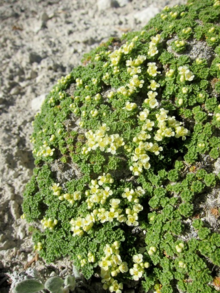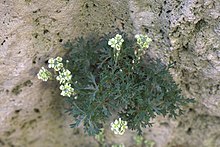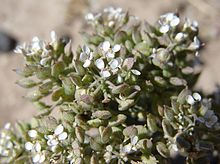Cresses
| Cresses | ||||||||||||
|---|---|---|---|---|---|---|---|---|---|---|---|---|

Garden cress ( Lepidium sativum ) |
||||||||||||
| Systematics | ||||||||||||
|
||||||||||||
| Scientific name | ||||||||||||
| Lepidium | ||||||||||||
| L. |
Cresses ( Lepidium ) are a genus of plants from the cruciferous family (Brassicaceae). Two types are used in the kitchen: the garden cress ( Lepidium sativum ) and the pepper herb ( Lepidium latifolium ).
description
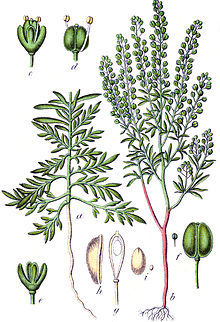

Vegetative characteristics
Lepidium species are annual or biennial to perennial herbaceous plants , less often sub-shrubs or even shrubs ; few species are climbing plants . The parts of the plant are not hairy or have different hairs depending on the species. The branched or unbranched stems are mostly erect or ascending, sometimes lying, prostrate or creeping.
The alternate, basal and distributed on the stem arranged (at Lepidium fremontii are no basal leaves present) leaves are sessile or pedunculated. The petiole is not clearly delineated from the leaf blade. The leaf blade is simple or pinnate. The leaf margins are whole, lobed, notched, serrated or serrated.
Generative characteristics
The inflorescences, which are initially umbrella- shaped, become racemose in some species until the fruit is ripe by stretching the inflorescence axes . There are no bracts .
The stalked, hermaphrodite flowers are radial symmetry and four-fold with a double flower envelope . The four sepals are usually egg-shaped or rectangular, rarely almost circular. There are usually four upright or spreading, white to yellow or pink petals , rarely they are rudimentary or missing. The petals can be nailed. Often only two stamens are present; it can be four or six. There are four or six nectar glands. Two carpels have become a top permanent ovary grown and have three ovules per ovary chamber. The stylus cannot be recognized until the crown protrudes with a mostly cephalic or rarely bilobed scar.
Its fruits are hairy or hairless, very differently shaped pods with only two seeds . The seeds can be winged.
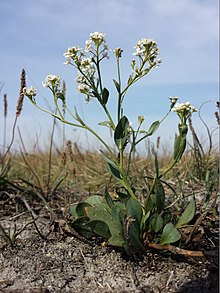
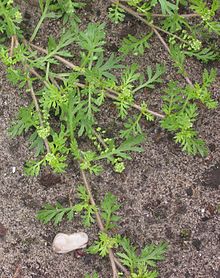





Systematics and distribution
The genus name Lepidium was first published in 1753 by Carl von Linné in Species Plantarum . As Lektotypusart was Lepidium latifolium set. The generic name Lepidium is derived from the Greek word lepidion or lepidos for scale and refers to the appearance of the fruit.
Al-Shehbaz et al. (2002) the species of the former genera Cardaria , Coronopus and Stroganowia were placed in the genus Lepidium . Synonyms for Lepidium L. are: Carara Medikus , Cardaria Desvaux , Coronopus Zinn , Neolepia W.A. Weber , Physolepidion Schrenk , Senebiera DC. , Sprengeria Greene , Stroganowia Karelin & Kirilow . The genus Lepidium belongs to the tribe Lepidieae within the family Brassicaceae .
The genus Lepidium is widespread in North America (42 species), Mexico, Central America, South America, Europe, Asia, Australia and in northern and southern Africa.
The genus Lepidium includes 140 to 220 species (here is a selection):
- Lepidium acutidens ( A.Gray ) Howell : It is found in Oregon , California and Baja California .
- Lepidium africanum ( Burm.f. ) DC. : It occurs in Africa and is a neophyte in Mauritius, Hawaii, New Zealand and Australia.
- Lepidium alashanicum H.L.Yang : It occurs in China.
- Lepidium alluaudii Maire : It occurs in Morocco .
- Lepidium alyssoides A.Gray : It is found in three varieties in the United States and Mexico .
- Lepidium apetalum Willd. (Syn .: Lepidium micranthum Ledeb. ): It occurs in Pakistan , India , Nepal , Kazakhstan , Tajikistan , Korea , Japan and in China.
- Lepidium appelianum Al-Shehbaz (Syn .: Cardaria pubescens ( CAMey. ) Jarm. , Hymenophysa pubescens C.A.Mey. ): It occurs in Pakistan, in Central Asia , in China and in Mongolia and is in the United States, Canada, Argentina and Siberia a neophyte.
- Lepidium arbuscula Hillebr. : It occurs in Hawaii .
- Lepidium aucheri Boiss. : It occurs in Egypt , Turkey , Syria , Jordan , Iraq , Iran , Pakistan, Turkmenistan and the Arabian Peninsula.
- Lepidium austrinum Small : It is found in the United States and Mexico.
- Lepidium barnebyanum Reveal : It is found in Utah .
- Lepidium bidentatum Montin : It occurs in Hawaii, French Polynesia, New Caledonia , Samoa and Tonga .
- Lepidium bonariense L .: It occurs in Brazil , Argentina , Paraguay , Uruguay and Chile and is a neophyte in Australia and South Africa.
- Lepidium brachyotum ( Karelin & Kirilov ) Al-Shehbaz
- Field cress ( Lepidium campestre ( L. ) WTAiton , Syn .: Thlaspi campestre L. )
- Lepidium capense Thunb. (Syn .: Lepidium africanum auct.): It occurs in southern Africa.
- Lepidium capitatum J.D. Hooker & Thomson : It occurs in China, Bhutan , India, Kashmir, Nepal and Sikkim .
- Lepidium cardamines L .: It occurs in Spain .
- Salt cress ( Lepidium cartilagineum ( JCMayer ) Thell. , Syn .: Lepidium crassifolium Waldst. & Kit. , Thlaspi cartilagineum J.C. Mayer )
- Lepidium chalepense L. (Syn .: Cardaria chalepensis ( L. ) Hand.-Mazz. , Cardaria draba subsp. Chalepensis ( L. ) OESchulz , Cardaria draba var. Repens ( Schrenk ) OESchulz , Cardaria repens ( Schrenk ) Jarm. , Lepidium draba subsp. chalepense ( L. ) Thell. , Lepidium draba var. repens ( Schrenk ) Thell. , Lepidium repens ( Schrenk ) Boiss. , Physolepidion repens Schrenk ): It occurs in Turkey, Syria, Lebanon, Israel , Jordan, the Sinai Peninsula , Iraq, Iran, Pakistan, Armenia , Turkmenistan and China and is a neophyte in the United States, Canada and Argentina.
- Lepidium cordatum Willdenow ex Steven : It occurs in Kazakhstan, Russia, Tajikistan, China and Mongolia.
- Lying crow's foot ( Lepidium coronopus ( L. ) Al-Shehbaz , Syn .: Cochlearia coronopus L. , Coronopus squamatus ( Forssk. ) Asch. , Lepidium squamatum Forssk. )
- Lepidium crenatum ( Greene ) Rydb. (Syn .: Lepidium montanum var. Spathulatum ( BLRob. ) CLHitchc. , Lepidium scopulorum var. Spathulatum B.L.Rob. , Thelypodium crenatum Greene ): It comes in Colorado , in New Mexico and Utah before.
- Lepidium culminicola Mouterde : It occurs in the area of Syria and Lebanon.
- Lepidium cuneiforme C.Y.Wu : It occurs in China.
- Lepidium davisii Rollins : It occurs in Idaho , Oregon and Nevada .
- Dense flowered cress ( Lepidium densiflorum Schrad. ): Their home is Canada, the United States and Mexico. In Europe, Asia and Argentina it is a neophyte.
- Lepidium dictyotum A.Gray : Found in the western United States and northern Mexico.
- Two-nodal crow's foot ( Lepidium didymum L. , Syn .: Coronopus didymus ( L. ) Sm. )
- Arrow cress ( Lepidium draba L. , Syn .: Cardaria draba ( L. ) Desv. , Cardaria draba subsp. Draba , Lepidium draba subsp. Draba )
- Lepidium eastwoodiae Wooton : It is found in the western and southern United States.
- Lepidium englerianum ( Muschler ) Al-Shehbaz : It was first described from tropical Africa.
- Lepidium ferganense Korshinsky : It occurs in Afghanistan , Kazakhstan, Kyrgyzstan, Tajikistan, Uzbekistan and Xinjiang .
- Lepidium flavum Torr. : It occurs in California, Nevada and northern Mexico.
- Lepidium Fremontii S. Watson : It occurs in Arizona, California, Nevada and Utah.
- Lepidium glastifolium Desf. : It occurs in Algeria and Tunisia.
- Grass-leaved cress ( Lepidium graminifolium L. , Syn .: Lepidium iberis L. )
- Mixed-leaved cress ( Lepidium heterophyllum Benth. )
-
Rough cress ( Lepidium hirtum L. Sm. ): There are about nine subspecies:
- Lepidium hirtum subsp. atlanticum Ball Maire : It occurs in Spain and Morocco.
- Lepidium hirtum subsp. calycotrichum (G. Kunze) Thell. : It occurs in Spain and Morocco.
- Lepidium hirtum subsp. dhayense (Munby) Thell. : It only occurs in Algeria .
- Lepidium hirtum subsp. hirtum : It occurs in Spain, France , Italy and Greece .
- Lepidium hirtum subsp. nebrodense Rafin. Thell. : It occurs in Italy, Sicily , Greece, Crete and the Aegean Sea.
- Lepidium hirtum subsp. oxyotum (DC.) Thell. : It occurs in Corsica and Crete .
- Lepidium hirtum subsp. petrophilum (Cosson) Thell. : It only occurs in Spain.
- Lepidium hirtum subsp. rifanum Emberger & Maire : It occurs only in Morocco.
- Lepidium hirtum subsp. stylatum (Lag. & Rodr.) Thell. : It occurs in Spain.
- Lepidium huberi S.L.Welsh & Goodrich : It occurs in Colorado and Utah.
- Lepidium integrifolium Nuttall : It occurs in Arizona, Nevada, Utah and Wyoming .
- Lepidium jaredii Brandegee : It occurs in California.
- Lepidium lacerum C.A. Meyer : It occurs in Kazakhstan, Mongolia and Xinjiang.
- Lepidium lasiocarpum Nutt. : It is found in the western and southern United States and northern Mexico.
- Pepper cabbage , broad-leaved cress ( Lepidium latifolium L. )
- Lepidium latipes Hooker : It occurs in California and Baja California.
- Lepidium lepidioides ( Coss. & Durieu ) Al-Shehbaz
- Lepidium lyratum L.
- Maca or Peruvian ginseng ( Lepidium meyenii Walp. , Syn .: Lepidium peruvianum G.Chacón de Popovici ): It is originally found in Peru , but is also cultivated in Peru, Bolivia and Argentina.
- Lepidium montanum Nutt. : It occurs in four varieties in the western and southern United States and northern Mexico.
- Lepidium nanum S. Watson : It occurs in Nevada and Utah.
- Lepidium navasii ( Pau ) Al-Shehbaz : It occurs in Spain.
- Misunderstood cress ( Lepidium neglectum Thell. ): It was introduced to Central Europe from North America.
- Lepidium niloticum sieve. ex Steud. : It occurs in Egypt.
- Lepidium nitidum Nutt. : It occurs in the western United States and northern Mexico.
- Lepidium o-waihiense Cham. & Schltdl.
- Lepidium oblongum Small : It is found in the United States, Mexico, El Salvador, and Guatemala .
- Lepidium ostleri S.L.Welsh & Goodrich : It occurs in Utah.
- Lepidium oxycarpum Torrey & A.Gray : It is found in California.
- Lepidium papilliferum ( LFHenderson ) A.Nelson & JFMacbride : It is found in Idaho .
- Lepidium paysonii Rollins
- Marble-leaved cress ( Lepidium perfoliatum L. ): It occurs in Central, Eastern and Southeastern Europe and Asia and is a neophyte in Australia, Argentina and North America.
- Lepidium persicum Boiss. : It occurs in Iraq, Iran, Afghanistan and Turkmenistan.
- Lepidium pinnatifidum Ledeb. : It occurs in Afghanistan, Pakistan, India, in Central Asia and in the Caucasus and is a neophyte in California and Argentina.
- Lepidium ramosissimum A. Nelson : It occurs in North America from Alaska to Mexico.
- Lepidium rigidum Pomel : It occurs in Algeria.
- Rubble cress , stink cress ( Lepidium ruderale L. )
-
Garden cress ( Lepidium sativum L. ): There are two subspecies:
- Lepidium sativum subsp. sativum
- Lepidium sativum subsp. spinescens ( DC. ) Thell.
- Lepidium schinzii Thell. : It occurs in southern Africa.
- Lepidium sordidum A.Gray : It occurs in Texas and Mexico.
- Lepidium spinosum Ard. : It occurs in Greece, Turkey , Syria, Lebanon and Israel and is a neophyte in the Balearic Islands.
- Lepidium strictum ( S.Watson ) rattan ex BLRobinson : It occurs in Oregon , California and Chile.
- Lepidium subulatum L .: It occurs in Morocco, Algeria and Spain.
- Lepidium thurberi Wooton : It occurs in Arizona , California, New Mexico and northern Mexico.
- Lepidium tiehmii ( Rollins ) Al-Shehbaz : It occurs in Nevada .
- Lepidium vesicarium L .: It occurs in Turkey, Armenia, Azerbaijan and Iran.
-
Villars cress ( Lepidium villarsii Gren. & Godr. ): It occurs in two subspecies in Spain and France:
- Lepidium villarsii subsp. anticarium ( Valdés Bermejo & G. López) Hernández Bermejo (Syn .: Lepidium hirtum subsp. anticarium (Valdés Bermejo & G. López) Greuter & Burdet ): You only occurs in Spain.
- Lepidium villarsii subsp. villarsii (Syn .: Lepidium reverchonii Debeaux ): It occurs in Spain and France.
- Lepidium violaceum ( Munby ) Al-Shehbaz : It occurs in Morocco.
- Virginian cress ( Lepidium virginicum L. ): It occurs originally in North and Central America and on the Caribbean islands in two subspecies. It is a neophyte in South America, Africa, Europe, Asia, Australia, New Zealand and on numerous islands in the Pacific.
use
The leaves of many species are eaten raw as a salad, sometimes cooked or used as a spice. The seeds of the field cress ( Lepidium campestre ) and the Virginian cress ( Lepidium virginicum ) are used as a pepper substitute. A kind of mustard can be made from the seeds of the dense cress ( Lepidium densiflorum ) . The seeds of Lepidium Fremdontii , Lepidium intermedium , Lepidium latifolium and Lepidium nitidum can be used as a spice. The roots of Lepidium meyenii have a sweet, good taste when cooked. From the seeds of the garden cress ( Lepidium sativum ) you can make cooking oil and use the germinated seeds as sprouts. The medicinal effects of many species have been studied.
swell
- Tai-yien Cheo, Lianli Lu, Guang Yang, Ihsan Al-Shehbaz, Vladimir Dorofeev: Brassicaceae. In: Wu Zheng-yi, Peter H. Raven (Ed.): Flora of China . Volume 8: Brassicaceae through Saxifragaceae . Science Press / Missouri Botanical Garden Press, Beijing / St. Louis 2001, ISBN 0-915279-93-2 , Lepidium , pp. 28 (English, online ). (Section description)
- Ihsan A. Al-Shehbaz, John F. Gaskin: Lepidium. In: Flora of North America Editorial Committee (Ed.): Flora of North America North of Mexico . Volume 7: Magnoliophyta: Salicaceae to Brassicaceae . Oxford University Press, New York / Oxford a. a. 2010, ISBN 978-0-19-531822-7 , pp. 570 (English, online ). (Sections Description, Distribution and Systematics)
- J. Gathe: Lepidium. In: Western Australian Herbarium (Ed.): FloraBase. The Western Australian Flora. Department of Environment and Conservation 2008, online.
- Ihsan A. Al-Shehbaz, Klaus Mummenhoff, Oliver Appel: Cardaria, Coronopus, and Stroganowia are united with Lepidium (Brassicaceae). In: Novon. Volume 12, No. 1, 2002, pp. 5-11, digitized .
Individual evidence
- ↑ Carl von Linné: Species Plantarum. Volume 2, Lars Salvius, Stockholm 1753, p. 643, digitized
- ↑ Nathaniel Lord Britton, Addison Brown: An illustrated flora of the northern United States, Canada and the British possessions, from Newfoundland to the parallel of the southern boundary of Virginia, and from the Atlantic Ocean westward to the 102d meridian. 2nd Edition. Volume 2, C. Scribner, New York 1913, p. 164, digitized .
- ↑ a b c d e f g h i j k l m n o p q r s t u v w x y z aa ab ac ad ae af ag ah ai aj ak al am Lepidium in the Germplasm Resources Information Network (GRIN), USDA , ARS , National Genetic Resources Program. National Germplasm Resources Laboratory, Beltsville, Maryland. Retrieved July 27, 2017.
- ↑ a b c d e f g h i j k l Ihsan A. Al-Shehbaz, John F. Gaskin: Lepidium. , P. 570 - same text online as printed work , In: Flora of North America Editorial Committee (Ed.): Flora of North America North of Mexico. Volume 7: Magnoliophyta: Salicaceae to Brassicaceae. Oxford University Press, New York and Oxford, 2010, ISBN 978-0-19-531822-7 .
- ↑ a b c d e f Tai-yien Cheo, Lianli Lu, Guang Yang, Ihsan Al-Shehbaz, Vladimir Dorofeev: Brassicaceae. : Lepidium Linnaeus. - Same text online as the printed work , In: Wu Zheng-yi, Peter H. Raven, Deyuan Hong (Ed.): Flora of China. Volume 8: Brassicaceae through Saxifragaceae. Science Press and Missouri Botanical Garden Press, Beijing and St. Louis 2001, ISBN 0-915279-93-2 .
- ↑ a b c d e f g h i j k l m n o p q Karol Marhold: Brassicaceae. Lepidium. In: Euro + Med Plantbase - the information resource for Euro-Mediterranean plant diversity. Berlin 2011.
- ↑ Jaakko Jalas, Juha Suominen, Raino Lampinen (ed.): Atlas Florae Europaeae. Distribution of Vascular Plants in Europe. 11. Cruciferae (Ricotia to Raphanus). Akateeminen Kirjakauppa & Tiedekirja, The Committee for Mapping the Flora of Europe & Societas Biologica Fennica Vanamo, Helsinki 1996, ISBN 951-9108-11-4 , pp. 202-203.
- ↑ Entries on Lepidium in Plants For A Future


